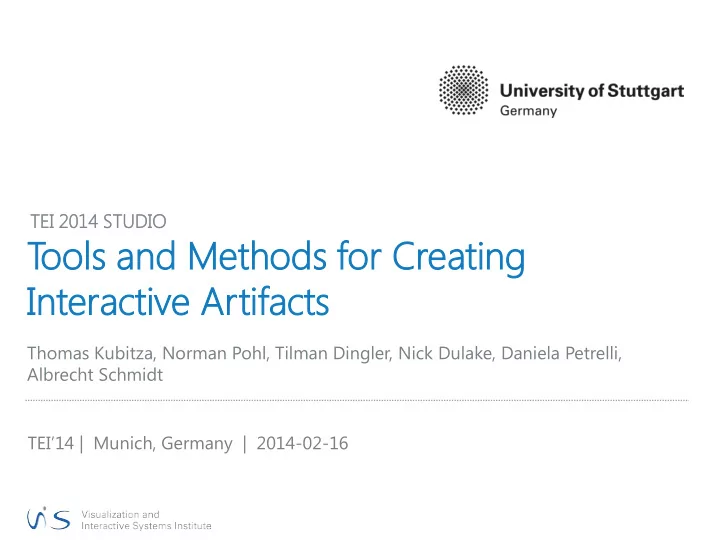

TEI 2014 S 2014 STUD UDIO T ools a ls and M Method ods f s for C Crea eatin ing Inter eracti tive e Artif ifacts Thomas Kubitza, Norman Pohl, Tilman Dingler, Nick Dulake, Daniela Petrelli, Albrecht Schmidt TEI’14 | Munich, Germany | 2014-02-16
Agenda 09:00-09:15 Introduction round 09:15-09:45 Session on form and function in smart artefacts and tangible interaction 09:45-10:30 Session on physical prototyping platforms – focus on cloud platforms 10:30-11:30 Discussion 11.00-12:30 Hands-on part I – Choose one platform to work with 12:30-14:00 Lunch break, free (tinkering) time 14.00-15:30 Hands on part II – Choose another platform to work with 16:00-16:30 Wrap-up, revisit form and function discussion, ideas on how to improve platforms and what is missing with the current platforms. 16:30-17:30 Free tinkering time 2
T eam Introduction Thomas Kubitza Nick Dulake University of Stuttgart Sheffield Hallam University Norman Pohl Daniela Petrelli Stuttgart Media Sheffield Hallam University University Tilman Dingler Albrecht Schmidt University of Stuttgart University of Stuttgart 3
MeSch Project MeSch – Material EncounterS with Digital Cultural Heritage 4 year EU project, currently in project month 13 12 European partners 3 Museums One of the goals: Providing tools for curators to create interactive artefacts and environments 4
Session I - Form and Function Presented by Nick Dulake Senior Industrial Designer at Design Futures Sheffield Hallam University 5
Session II – Physical Prototyping Platforms Presented by Thomas Kubitza Researcher and PhD student at HCILAB Stuttgart University of Stuttgart 6
Why Hardware Hacking? Arduino 3D Printing Laser cutting CNC milling Conductive Ink printing DIY Communities, FabLabs Fig.1: Pebble Smartwatch [3] YCombinator: 7/84 startups make hardware [1] Pebble Smartwatch: $10 Mio funding on kickstarter [2] [1] http://www.paulgraham.com/hw.html [2] http://bits.blogs.nytimes.com/2012/05/11/pebble-smartwatch-tops-out-at-10-million-on-kickstarter/ [3] http://getpebble.com/ 7
Creating Opportunities for Research New hardware makes people explore new research questions Fig.3: Microsoft Kinect [2] Fig.2: Wii controller [1] Researchers who can build new hardware can open up new domains [1] source: http://www.nintendo.com/wii [2] source: http://www.xbox.com/en-US/KINECT 8
Designing a hardware platform for ubiquitous computing research Trade-offs Self-contained vs. extendable Size and weight vs. DIY friendliness Requirements Processing Connectivity Sensing Actuation 9
Lessons Learned from Smart-Its Modular open hardware is great. Miniaturization is key to move beyond proof-of-concept implementation DIY is not enough… 10
Lessons Learned from Arduino - More than one form factor required Development support / programming language is key Powerful computing and multimedia are tough 11
Lessons learned (from Gadgeteer) Need for lighter SDK Form factor and energy consumption matters 12
Recent Prototyping Platforms 13
DIY HW platforms range …. Raspberry Pi / Beaglebone Seeeduino Film / Xadow high processing power low processing power • • (700Mhz-1GHz) ( 8Mhz) credit card sized small size • • high power consumption low power consumption • • (5V – >500mA) (3,3V – 1,2uA / 3mA) 14
Arduino - MCUs Arduino Uno Mini Micro Funnel IO Seeeduino Film / Xadow 15
Arduino - Seeeduino Film Atmega168 – 8Mhz 3,3V - 1,2uA / 3mA Flex Bus (20 pin) Chainable Cutable 16
Arduino - Xadow ATmega32U4 – 16Mhz 3,3V Flex Bus, Chainable Many components (OLED, BLE…) Micro USB (progr. /charging) http://xadow.cc/ 17
Arduino – Funnel IO (FIO) ATmega328V running at 8MHz 0.1mA / 3.8mA Xbee Socket Lithium Polymer battery connector Charged via mini USB 18
.NET Gadgeteer FEZ Spider Mainboard (ARM7, 72MHz, 16MB RAM) > 100 modules 19
Electric Imp MCU with embedded Wi-Fi SD card size Initial setup via Phone-App Programming via Web IDE Cloud / client components Language: Squirell 20
Electric Imp – Quick Demo Live Demo: Webbased IDE 21
mBed ARM Cortex M0 – M4 30-204Mhz USB storage drive Web IDE C/C++ Social coding, Code DB, GIT integration Cloud optimized compilation -- Debuging with Web IDE Desktop IDE 22
Credit Card Sized Computers RaspBerry Pi 700MHz, 512(256)MB RAM cost 25€ (!!!) BeagleBone 1GHz, 512 MB RAM cost 55€ Full OS: Linux, Android,… Easy extension with USB Output via HDMI / audio Many IO ports, no Ain 23
Blidgets Platform 24
Blidgets Brand new Rapid Prototyping platform created at HCILAB Stuttgart Ultra-low power (<1uA sleep / 30uA) Powered by coin-cell, LiPo battery or external supply Bluetooth Low Energy wireless connection to PCs and smartphones 18 GPIO ports, 5 Ain, 4 PWM, UART, I2C, SPI Vertically stackable and horizontally chainable Tiny form factor : 3g, 25x25x4mm Instantly programmable and controllable trough a Web based UI JavaScript for programming system logic 25
Blidgets - Extensions 26
Blidgets – Web IDE Quick DEMO 27
T owards a Unified Platform 28
Before Hands-On: Q&A 29
Hands On! (finally…) Four workbenches: mBed (Web Based IDE, C) Electric Imp (Web based IDE, Squirell) Xadow (Arduino IDE, Wiring/C) Blidgets (Web based IDE (Alpha!), JavaScript) For the first slot please choose one platform (now) For the second slot choose another platform (later) Use the instruction sheets to get started 30
References Kubitza T. et al, Ingredients for a New Wave of Ubicomp Products , IEEE Pervasive Computing Journal, 2013, Issue 13 31
Recommend
More recommend